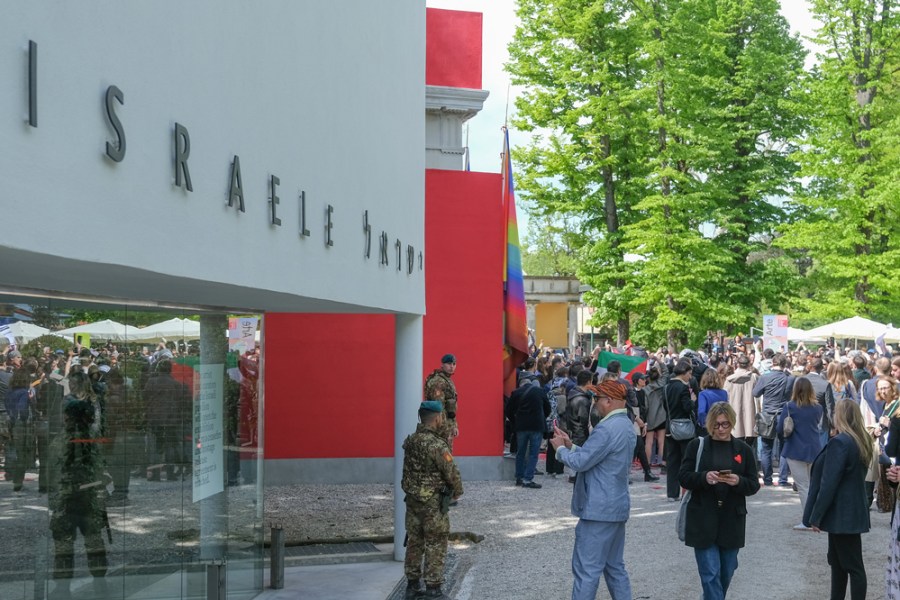Plus: the historic Copenhagen stock exchange building has been devastated by a fire

A protest against the conflict in Gaza takes place near the Israel pavilion at the 2024 Venice Biennale. Photo: Photo by Stefano Mazzola/Getty Images
The artist and curators representing Israel at the Venice Biennale have closed the national pavilion in protest at the Israel-Hamas war. A sign taped to the door of the pavilion reads, ‘The artist and curators of the Israeli pavilion will open the exhibition when a ceasefire and hostage release agreement is reached.’ Tamar Margalit, one of the curators of the pavilion, said that the government of Israel, which funded around half of the pavilion’s cost, was not informed in advance about the closure. Before the event, Israel’s presence at the Biennale prompted an open letter to be organised by the Art Not Genocide Alliance (ANGA) group, which was signed by nearly 24,000 people including artists who are presenting work at other national pavilions. The New York Times reports that one of the video pieces by Ruth Patir, the artist chosen to represent Israel, can still be seen through the window of the pavilion. ANGA commented on Instagram that this makes the closure a gesture ‘timed for maximum press coverage’. The Venice Biennale opened on 20 April, after three days of previews.
The historic Copenhagen stock exchange building has been devastated by a fire. The Boersen, home to Denmark’s chamber of commerce and its antecedents since the 19th century, was undergoing renovations when the blaze broke out on Wednesday morning. Its 56-metre spire, which took the shape of four intertwined dragon tails, collapsed in the flames. The building, which dates to 1624, also contained paintings by Danish artists such as Lorenz Froelich, C.F. Hoeyer and Peder Severin Kroeyer. The Art Newspaper reports that hundreds of artworks appear to have been rescued by museum curators, security staff and passers-by. Denmark’s chamber of commerce has said that it will reconstruct the building ‘no matter what’. The cost has been estimated to be one billion Danish krone (almost £115m).
The CEO of Museum Wales, a government-sponsored body that comprises seven Welsh museums, has announced the axing of at least 90 jobs and warned that National Museum Cardiff and other institutions may close. Jane Richardson told the BBC that Museum Wales’s budget was £700m less in real terms than in 2021, and that it had to address a deficit of £4.5m by the end of March, which she attributed mostly to a £3m reduction in Museum Wales’s government grant. The staff cuts amount to one in six being lost. Richardson stated that the museums will close earlier in the winter and that visitors will be charged for tours and exhibitions. With leaks and electrical failures, National Museum Cardiff is said to require urgent maintenance. (Its neighbour City Hall, a building of the same age, was closed by Cardiff council last year for essential maintenance work, and is not scheduled to reopen until 2026.) ‘Unless we’re able to secure more funding for [National Museum Cardiff],’ Richardson told the BBC, ‘[it] will have to close.’
Sylvain Amic has been appointed chair of the Musée d’Orsay in Paris. He will be replacing Christophe Leribault, who was appointed chair of the Château de Versailles in February. Amic, a former director of the Musée des Beaux-Arts de Rouen, has been an adviser to the French government on arts and crafts since 2022. The Swedish curator Fatima Hellberg will be the new general director of the Museum of Modern Art (Mumok) in Vienna. She is arriving from the Kunstverein in Bonn, and will succeed Karola Kraus, who has been in the position for 15 years. Hellberg has curated exhibitions at the Tate Modern, the Institute of Contemporary Arts in London and the CCA Wattis Institute for Contemporary Arts in San Francisco. Julia Marciari-Alexander is stepping down as director of the Walters Art Museum after a decade to become president of the Samuel H. Kress Foundation. The foundation is a grant-giving body that describes its mission as supporting ‘the study and presentation of European art, architecture and archaeology in the United States’.





